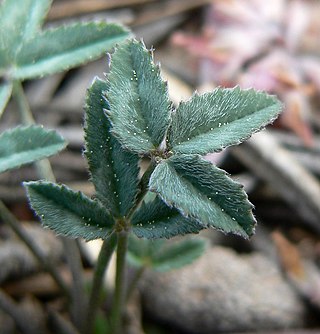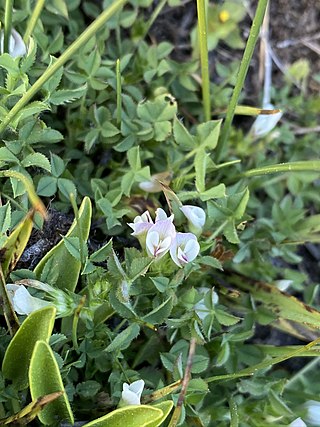
Helianthus bolanderi is a species of sunflower known by the common names Bolander's sunflower and serpentine sunflower. It is native to California and Oregon, where it grows mainly in mountainous areas, often in serpentine soils. It has been found from southwestern Oregon as well as in northern and central California as far south as Santa Cruz County, with reports of a few isolated populations in southern California.

Astragalus bolanderi is a species of milkvetch known by the common name Bolander's milkvetch. It is native to western Nevada and parts of the Sierra Nevada in California. It grows in dry, rocky habitat on mountain and plateau.

Enceliopsis covillei, known by the common name Panamint daisy, is a rare North American desert species of flowering plant in the family Asteraceae.
Eryngium pinnatisectum is an uncommon species of flowering plant in the family Apiaceae, known by the common names Tuolumne eryngo and Tuolumne button celery.

Leptosiphon nuttallii is a species of flowering plant in the phlox family known by the common name Nuttall's linanthus.
Scutellaria bolanderi is a species of flowering plant in the mint family known by the common name Sierra skullcap. It is endemic to California, where it is known from the Sierra Nevada and several of the mountain ranges to the south. It is a perennial herb producing an erect stem or cluster of stems 30 centimeters to one meter tall from a system of thin rhizomes. The stems are coated in short, spreading hairs which sometimes have resin glands. The oval or heart-shaped leaves have wavy edges and are oppositely arranged. The lowest leaves are borne on short petioles. Flowers emerge from the leaf axils. Each flower is held in a calyx of sepals with a large ridge or appendage on the upper part. The corolla is between 1 and 2 centimeters long and tubular in shape with a large upper and lower lip. The upper lip is folded into a beaklike protrusion and the lower has three wide lobes. The corolla is white or very pale blue with an area of blue mottling on the lower lip.

Packera bolanderi is a species of flowering plant in the aster family known by the common names Bolander's ragwort and seacoast ragwort. It is native to the west coast of the United States from Washington to northern California, where it grows in wet coastal forests and woodlands. There are two varieties of the species which differ slightly in morphology and habitat occupied; these varieties have been considered separate species by some authors. The var. bolanderi has thicker leaves, occurs farther south, and occupies more open types of habitat, than does var. harfordii. This plant in general is a perennial herb producing one to three stems up to half a meter tall. The basal leaves have blades up to 12 centimeters long which are divided into several lobes and borne on long, thin petioles. Leaves growing farther up the stem are smaller and have more lobes on their blades. The inflorescence contains several flower heads, each lined with dark green phyllaries. The head contains many golden yellow disc florets and generally either 8 or 13 yellow ray florets each over a centimeter long. The fruit is an achene tipped with a pappus of bristles.
Trifolium andersonii is a species of clover known by the common names fiveleaf clover and Anderson's clover. It is native to the western United States, particularly the Great Basin and adjacent high mountain ranges, including the Sierra Nevada. It was named after Charles Lewis Anderson by Asa Gray.
Trifolium barbigerum is a species of clover known by the common name bearded clover.
Trifolium beckwithii is a species of clover known by the common name Beckwith's clover.

Trifolium depauperatum is a species of clover known by the common names cowbag clover, poverty clover, and balloon sack clover.

Trifolium eriocephalum is a species of clover known by the common name woollyhead clover or hairy head clover.
Trifolium gracilentum is a species of clover known by the common names pinpoint clover and slender clover. It is native to western North America including the west coast of the United States and northwestern Mexico, where it grows in many types of habitat, including disturbed areas. It is an annual herb growing prostrate to erect in form with mostly hairless or slightly hairy herbage. The leaves are made up of lance-shaped to oval leaflets. The inflorescence is an umbel of flowers that spread out or flex downward. The flowers have pink or purple corollas less than a centimeter long.

Trifolium gymnocarpon is a species of clover known by the common name hollyleaf clover.
Trifolium lemmonii is a species of clover known by the common name Lemmon's clover.

Trifolium macrocephalum is a species of clover known by the common name largehead clover or bighead clover native to the Great Basin region of the western United States.

Trifolium microcephalum is a species of clover known by the common names smallhead clover and small-headed clover.

Trifolium monanthum is a species of clover known by the common name mountain carpet clover.

Trifolium variegatum is a species of clover known by the common name whitetip clover. It is native to western North America from southern Alaska and British Columbia to Baja California, where it occurs in many types of habitat.
Trifolium jokerstii is a rare species of clover known by the common names Jim's clover and Butte County golden clover. It is endemic to Butte County, California, where it is known from eight or nine occurrences near Oroville. It grows in seasonally moist habitat, such as vernal pools, pastures, and ephemeral creeks. It was previously included within the description of Trifolium barbigerum as an odd yellow-flowered variant of a mostly purple-pink-flowered species, and was elevated to species status in 1998. It was named for the California botanist Jim Jokerst.











